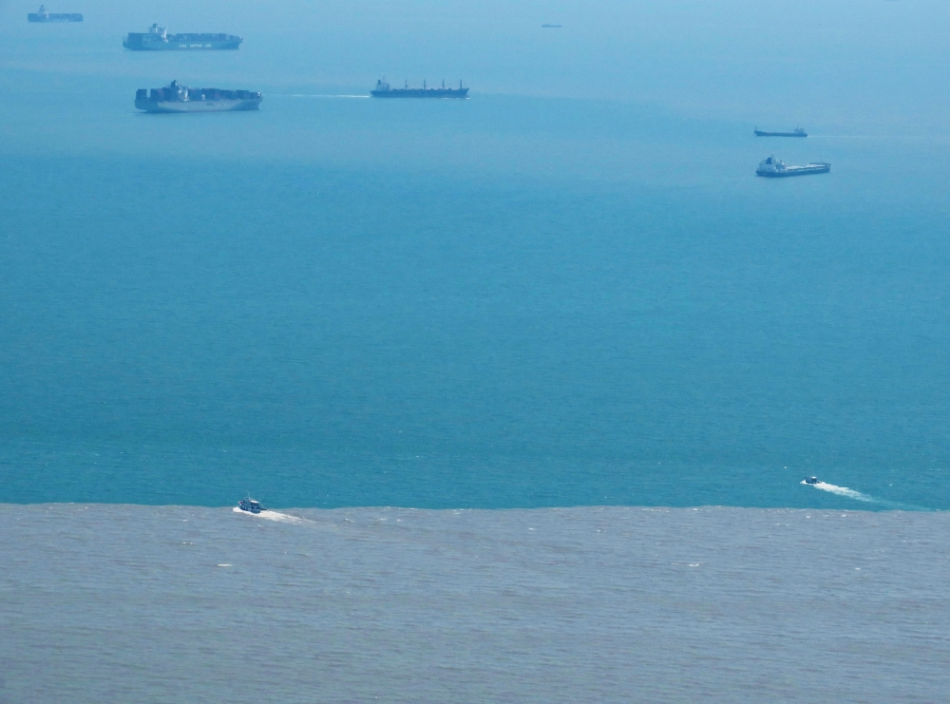Sep 30 2020
In the last few decades, the global ocean has become more stable and layered with global warming, which impacts life in the ocean by decreasing oxygen and nutrients.
 The Ocean color difference when two water masses meet. Image Credit: Zhu Jiang.
The Ocean color difference when two water masses meet. Image Credit: Zhu Jiang.
According to scientists from the Institute of Atmospheric Physics (IAP) of the Chinese Academy of Sciences and their collaborators from the United States, the Earth’s ocean has become more layered and impervious to vertical mixing as warming from the surface generates more stratification
The new study was published in the September 28th issue of the Nature Climate Change journal.
Seawater usually forms layers, with lighter water closer to the surface and denser water at deeper levels, that is, warmer fresher water above colder water with more saline. This kind of stable stratified configuration serves as an obstacle to water mixing, impacting the efficiency of vertical exchanges of oxygen, carbon, heat, and other elements.
As greenhouse warming, caused by man, has basically changed the oceanic temperature and salinity fields, effects on stratification are anticipated but the details have been hard to distinguish until now.
The core basis for approximating the stratification change is the scant distribution of ocean observations both vertically and horizontally. Former quantification of stratification alteration has been restricted to a basic index and has overlooked the spatial complexity of ocean density change.
The latest research gave an estimate on ocean stratification for the upper 2000 m along with its spatial structures. It used prudently assessed ocean temperature and salinity data (IAP products), which resolves former systematic biases related to sampling.
Furthermore, the research implemented a better metric of stratification (associated with the density gradient over depth) and subsequently provided a real estimate of ocean stratification and its variations.
The latest data also revealed that since 1960, the ocean has become more stratified by 5.3% for the upper 2000 m. But an even greater increase in ocean stratification of as much as 18% has been identified for the upper 150 m.
This observed long-term increasing trend of ocean stratification is mostly caused by stronger ocean warming for upper layers against the deep oceans (~97%), but salinity variations have a crucial role to play locally. This stratification increase exposes a strong human-caused change in the ocean caused by the long-term temperature and salinity change structures. Thus, this observed ocean stratification increase is another indisputable piece of proof of human-caused global warming.
In the tropics, there is a highly robust stratification increase at the upper 200 m, indicating a substantial change in tropical thermocline depth, which is crucial to the El Nino phenomenon. In the high and middle latitudes, substantial increases in ocean stratification are seen below 500 m, suggesting an impact on the stability of deep oceans caused by climate change.
With greater stratification, heat from climate warming cannot enter the deep ocean quite easily, which helps increase the surface temperature. It also decreases the capability of ocean carbon storage, worsening global warming. It also stops the vertical exchanges of oxygen and nutrients, and negatively influences the food supply of entire oceanic ecosystems.
The Strategic Priority Research Program of the Chinese Academy of Sciences, National Key R&D Program of China, and Key Deployment Project of Center for Ocean Mega-Research of Science, CAS supported the study.
Journal Reference:
Li, G., et al. (2020) Increasing ocean stratification over the past half-century. Nature Climate Change. doi.org/10.1038/s41558-020-00918-2.